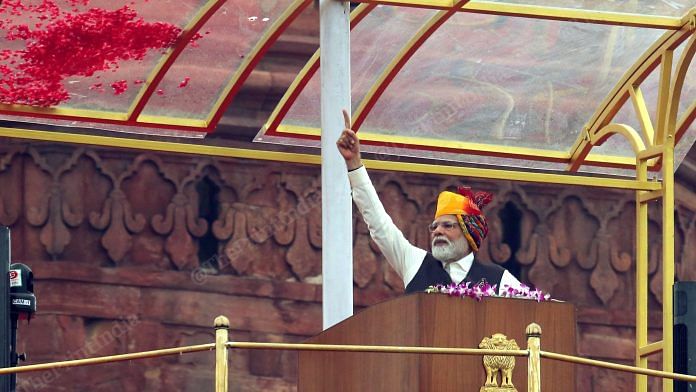Prime Minister Narendra Modi’s Independence Day address was truly unfolding the vision of aspirational India. From the “Tryst with Destiny” on 15 August 1947, when the country was one of the poorest economies living from “ship to mouth” and with political instabilities and threats to its security, democratic framework (during the infamous Emergency), India has moved to become a formidable military power, fifth largest economy in the world, a vibrant democracy and not only self-sufficient in food production but capable of food exports.
PM Modi has unfolded government’s actions, programmes and achievements with a promise that what the country will do in the next few years will lay foundations of a strong India for the next one thousand years. Referring to the one thousand years of slavery, defeats and setbacks, the Prime Minister identified the present time frame as “amritkaal”, “a milestone between one thousand years of slavery and one thousand years of grand future that is about to come”.
The Prime Minister has rightly flagged some of the strengths of the country that will stimulate growth and put the nation on the path to progress.
Also read: Sri Lanka can’t move on from civil war history. Sinhala elite insecure about sharing power
The growth promises
Moving from being the tenth largest global economy, India is already the fifth largest in the world. Though many economies around the world are yet to recover from the pandemic-induced shocks and the ongoing Russia-Ukraine conflict, the Indian economy has expanded by 6.1 per cent in the fourth quarter of FY23, resulting in an annual growth rate of 7.2 per cent. Going beyond the $3 trillion-mark, the GDP touched the $3.75 trillion-mark in 2023 as confirmed by the Finance Ministry. After the US, China, and Germany, India has the fourth-highest GDP at the current price parity.
India is among first three startup economies of the world. Startups have no doubt put India on the new industrial map of the world, preparing us for Industry 4.0. Yet, these new engines of economic growth face several roadblocks such as funding, hostile takeovers, and market manipulations. These startups need a good amount of handholding and support besides tax reliefs.
India has enormous potential to be the largest consumer market and production centre at the same time. The 7.2 per cent GDP growth should be attributed to the robustness of the services sector and insatiable consumer market. It is important for the government to strengthen the Micro, Small and Medium Enterprises (MSME), instead of supporting only a few large industrial houses who can anyway look after their interests.
India is all set to play a major role in global supply and value chain through a series of global and regional forums and institutions. The Indo-Pacific Economic Framework (IPEF) promises to be a game changer where India is poised to play a seminal role.
Also read: Ashoka University’s real issue is the clash between ‘suits’ that fund and ‘boots’ that run it
The pre-conditions
Prime Minister’s vision no doubt requires political stability as a template to work on and eradicate the ills that plague the democracy. The PM identified corruption, nepotism (dynastic politics) and appeasement as three evils that he is committed to fight. The use of technology has no doubt assisted the government in its effort to fight corruption. Yet, much more needs to be done. Technology is like a double-edged sword, which can be a good servant and a bad master depending on who uses it and to what purpose. Cybercrimes are on the rise and use of technology for frauds are outpacing the crime detection agencies and their methods.
The government needs to invest much more in technology, spruce up the technology transfer process and prepare the higher educational institutions for the institution-industry interface. The PM mentioned in his address that an increasing number of youth is veering towards STEM (Science, Technology, Engineering and Maths). But the overall pedagogy needs revolutionary changes and greater budgetary allocation for research. The government has established National Research Foundation (NRF), an apex body to provide high-level strategic direction of scientific research in the country as per recommendations of the National Education Policy (NEP), at a total estimated cost of Rs 50,000 crore during five years (2023-28), to be administered by the Department of Science and Technology. It is no doubt a great idea, but considering the funding required for research, it would not be out of place to suggest here that the government should scale it up to the levels of the US agency DARPA (Defense Advanced Research Projects Agency) with an annual budget of $3.87 billion.
The Prime Minister’s vision of a developed India by 2047 involves not just governments but also the people, including political parties. His dream must be the dream of India, every Indian, and inclusive. To that end, there needs to be a consensus among all stakeholders.
Seshadri Chari is the former editor of ‘Organiser’. Views are personal.
(Edited by Anurag Chaubey)



